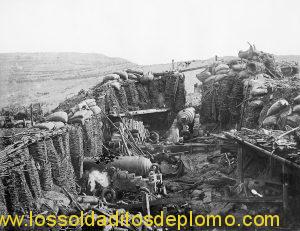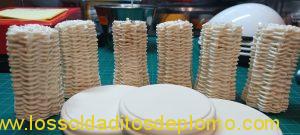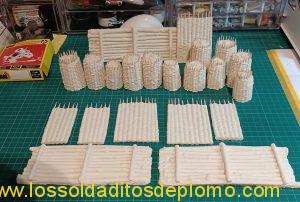Fabricación de Gabiones
AUTOR: Juan Carlos Santiago Guinea
GABIONES. Fortificaciones de campaña.Remontandose su uso al 3000 ADC y siendo inicialmente aplicado en construcciones de arquitectura civil, el empleo de los gabiones (*) como elementos de protección militar de la artilleria en campaña como en fortificaciones defensivas o de asedio comienza a hacerse extensivo con la llegada de la pólvora y de las armas de fuego al arsenal de los ejércitos europeos.Desde comienzos del siglo XV hasta la primera guerra mundial existe información constatando su uso como elemento de fácil obtención con los recursos que proporciona el terreno.De forma circular o tronco cónica y de diferentes tamaños , se constata su presencia en grabados , litografías y fotografías en todo conflicto militar.La realización artesanal a escala de un gabion no entraña una dificultad especial y puede hacerse con elementos simples que tenemos todos en casa.Mondadientes , cuerda o alambre de estaño o de cobre , un poco de plastelina y arena o grava fina es todo lo que necesitaremos.En las fotografías siguientes puede verse el proceso de construcción, imprimación y sellado de huecos para poder confeccionar un molde y realizar copias en serie con resina de poliuretano.Como elemento de escenificacion acompañando a una figura o como parte de una viñeta o diorama más complejo es un clásico totalmente recomendable.Os animo a probarlo y espero disfrutéis como yo.(*) : Del italiano “gabbione” o jaula grande.
GABIONS. Field fortifications.Dating back to 3000 ADC and being initially applied in civil architecture constructions, the use of gabions (*) as elements of military protection for the artillery in the war field as well as in defensive or siege fortifications began to become extensive with the arrival of the gunpowder and firearms to the arsenal of European armies.From the beginning of the XVth C. until the WW1 there exist a lot of information confirming its use as a defensive item which can be easily built with the resources provided by the land. Tree branches and fascines.With a circular shape and in different sizes, the fascine gabions can be seen in engravings, lithographs and photographs in almost all military actions during the last 500 years.The craftsmanship of a scale model gabion is not difficult at all and can be easily done with some simple elements that we all have at home.Toothpicks, thin rope or rigging thread, or even tin or copper wire with some clay and sand or fine gravel is all that we need.In the following photographs you can see the process of construction, priming and sealing of gaps to make a silicone mould and the copies with urethane resin.As a scenery element beside a figure or as part of a more complex vignette or diorama, it is a fully recommended classic item in your collection that you can not miss.I encourage you to try it and I hope you will enjoy it as much as I did.(*) GABION : From the Italian “gabbione” or large cage.





















